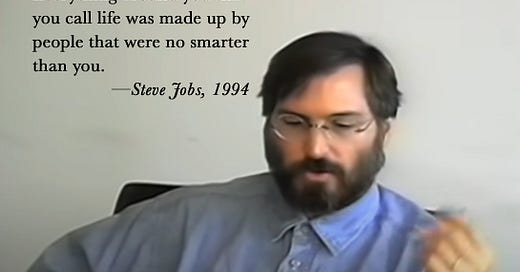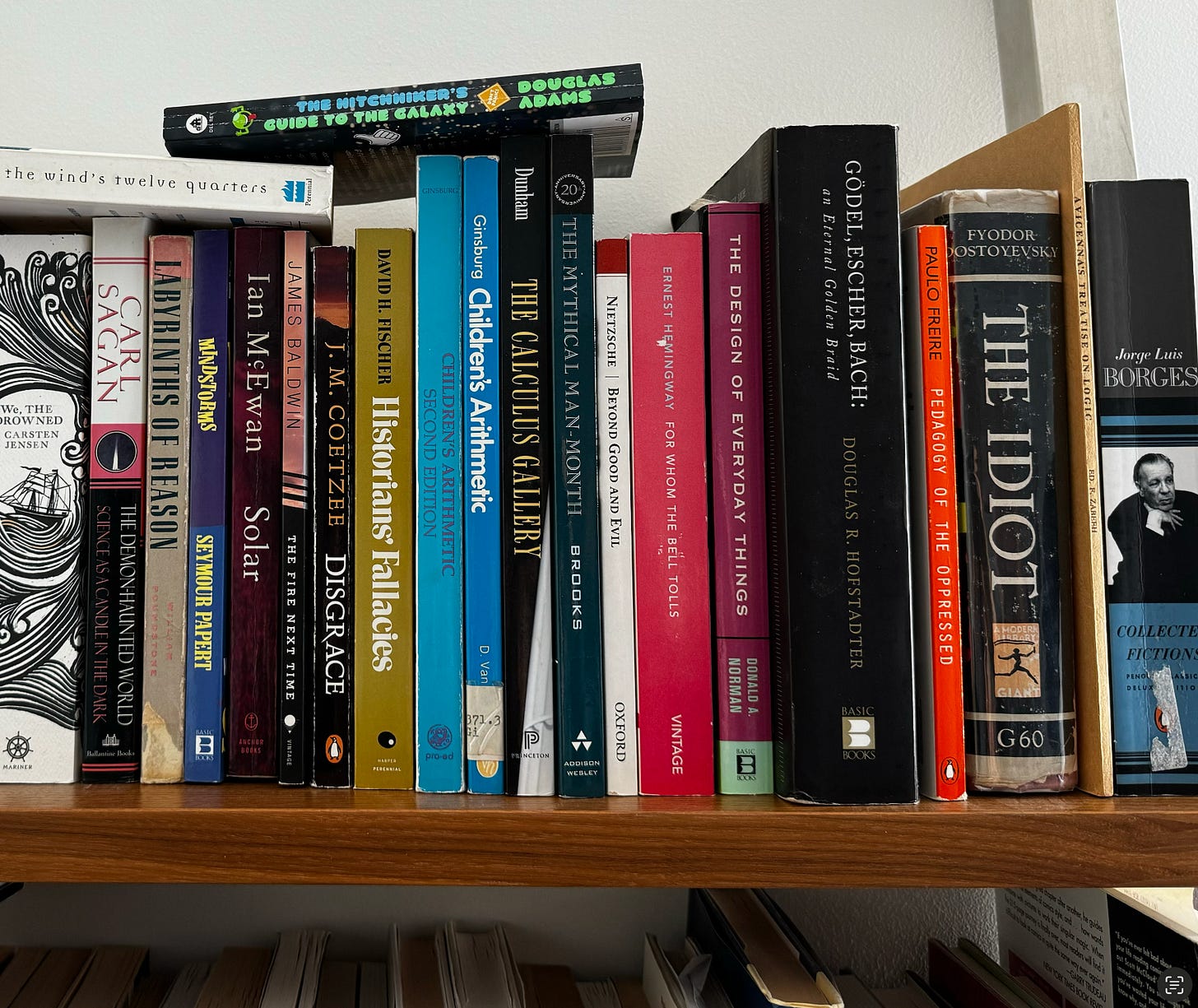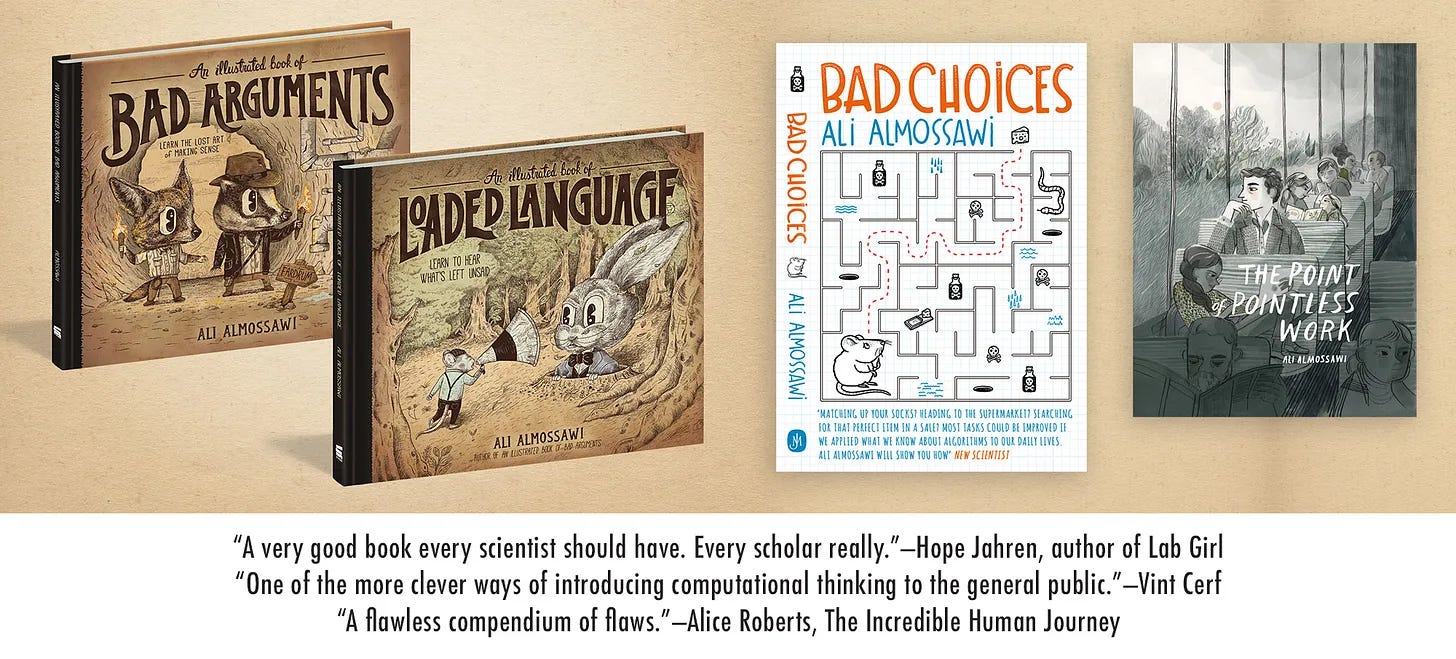A Question That’ll Keep You Curious
Reflections on following through on an idea, an app to help manage your bookshelf, a manuscript update, and a portrait from Bedlam
Issue No. 28
I hope you don’t mind an intermission. This issue was supposed to be on 10 patterns of loaded language—bite-sized lessons on media literacy to help K-12 educators teach the subject to school kids. But I got so engrossed in a project that I ended up spending entire days and evenings in cafes making progress on it and lost track of time. I’ll cover that original topic next time.
There’s a new trend in San Francisco of cafes that stay open until 11 at night. They tend to be full of night owls, vigorously typing on their computers until the baristas ask them—ask us—to kindly begone. (Have you no loved ones to go home to, people?)
My distraction started, as these projects often do, with the question,
Wouldn’t it be nice if …
As in,
Wouldn’t it be nice if I could look at my messy bookshelf and know exactly where a book is?
A derivative question of a grander one posed by a good friend over lunch one day that I’d like to ultimately work toward. That would be nice. Wave your phone at your bookshelf and get an answer. I know I have that problem often. I’ll be looking for a book, and might remember the title or part of the author’s name or what color the cover is, but won’t always be able to find the book right away.
As of last year’s release of iOS, you can take a photo and then tap the icon that appears in the bottom right corner (it’s in the above photo too), and it’ll give you a best-effort attempt at detecting all the text in the photo. However,
Wouldn’t it be nice if you could curate and archive that digital version of your bookshelf?
As in, not only be able to detect titles, but tap on a color-coded one and see where its corresponding book is. Or effortlessly edit titles that weren’t detected correctly. Or keep track of all your shelves and be able to go back in time and see how your taste might have changed.
The trouble was I didn’t know the first thing about making an app for a phone that could do any of that. Wouldn’t it be nice if I did? I spent the past two weeks doing just that. Asking a series of “Wouldn’t it be nice” questions, and learning about the language, tools, infrastructure, policies, and regulations that are part of the workflow that takes an idea on your computer and puts it in front of a billion users in the App Store.
I’d love to share with you all what I ended up with.
It’s called Bookshelf Buddy. If you think you’d enjoy using it you can pre-order it and the App Store will let you know once it’s ready to download. I’m targeting October for an initial release. It’ll be free to use, and I’ll open-source the code. It’s a v0.1 so there’s still a way to go to get this to a feature-complete state that does everything I’d like it to.
If this triggers any ideas, send them my way or add a comment below.
Reflections from the past two weeks
1 Follow-through is an inexpensive way of testing an idea. We all have moments of inspiration when we wonder why something doesn’t exist in the world, and how nice it would be if the thing did exist. It takes a small shift in perspective to go from observing something like that to realizing there’s nothing stopping us from making it so. Oftentimes, we don’t need to reinvent the universe to follow through on an idea. All it takes is spending some time seeing how we and others feel about the idea as it takes shape.
Everything around you that you call life was made up by people that were no smarter than you. And you can change it, you can influence it. You can build your own things that other people can use. And the minute that you understand that you can poke life and actually something will, you know, if you push in, something will pop out the other side. You can change it, you can mold it, that’s maybe the most important thing.
—Steve Jobs (The Santa Clara Valley Historical Association, 1994)
2 Regularly wind and unwind. Execution requires momentum, and momentum requires short-term goals that keep you motivated. Goals that will safeguard your mind from being overwhelmed or from veering into the realm of unhelpful thoughts. I’ve been in that realm. It’s terrifying, frankly. For the type of projects I enjoy doing, my ideal cadence is on the order of weeks. As in, spending a few weeks winding up as I learn something new and then rapidly unwinding and sharing my work with others. Then going back and doing that all over again. It’s my favorite mental model for staying curious and not burning out.
3 Do things you have no business doing. I love doing things I have no business doing. Within reason.1 There’s a thrill to sloppily trying something for the first time. You’re not shackled by the tyranny of assumptions nor the constraint of expectations. Constraints and expectations are useful. They give you structure. They’re how people are kept accountable and how a businesses fulfill their duties. What’s equally useful is carving out time every now and again for child-like, expectation-less creative meandering that’s done merely for the satisfaction of doing the thing.
4 Patient teachers are priceless. I’m not sure I would have been able to finish this app in two weeks, in a programming language I’d never coded in (Swift), had I not had access to an AI copilot, essentially. Something—some one—I could bug with questions without worrying about whether they’d get annoyed at me. I feel we’re all that way as children, but then something happens as we grow older. Some of us become a bit more wary of asking questions.
It was a reminder of how priceless patient teachers are. Of how much they influence us during our most formative points in life when we’re at our most vulnerable. An educator that never makes a student feel self-conscious about asking questions does an immense service to that student.
5 AI is helpful as a teaching tool, so long as you have core competencies in the subject. There were multiple points during my interactions with my faceless interlocutor where I second-guessed their approach or advice. For instance, they’d give me a piece of code that worked, but broke some design pattern or engineering heuristic. Generally speaking, I had to nudge it in all the right ways for it to produce something that matched what I had in mind. And so, I felt from this experience, that our back and forths were constructive when one has some amount of knowledge of fundamental concepts.
Manuscript updates
I’ve finished editing a manuscript I’ve been working on for a few months now. It’s a whimsical story with a tender undertone, at around 64,000 words. I’m figuring out how to position it for publishers as I don’t have much experience with fiction that sells. (Fiction that doesn’t sell, however, I’m the king of that. Ask me anything.) I’ve shelved every other work of fiction I’ve ever written, though I’m hoping this one will see the light of day.
My plan is to start on two manuscripts near the end of this year. One, for the third and final book in the Bad Arguments series. It will complement the other two titles well and make for a great box set. I expect that to take around nine months to finish, so I’m targeting late 2025 to have it ready to hand over to a publisher. And two, a portable collection of essays on critical thinking. They’ll be focused on practical advice and will be a succinct adaptation of the lessons in these emails from the past year and a bit.
A familiar portrait
I attended an event for a publisher last week and the venue had this portrait up by the restrooms. I’d seen it before at a friend’s house. It’s of a patient during the 1800s from a psychiatric hospital in London, better known as Bedlam. A word that’s still in common use though it’s definition has changed to mean a scene of uproar and confusion. Some interesting context about the name and how it came to be.
In 1247 the Priory of St Mary of Bethlehem was founded, devoted to healing sick paupers. The small establishment became known as Bethlehem Hospital. Londoners later abbreviated this to ‘Bethlem’ and often pronounced it ‘Bedlam’.
The most important reason for going from one place to another is to see what’s in between, and they took great pleasure in doing just that.
―Norton Juster (The Phantom Tollbooth)
Until next time.
Be well,
Ali
P.S. There was an article written by Haley Bierman on International Literacy Day that had a short section in it about my books. Here it is.
P.P.S. If you missed it, here’s a 60-second video of how I made the book earrings from a few issues ago: YouTube Short, Instagram Reel
Rest assured, your upcoming surgery will be performed by a professional.










This is a brilliant idea! I have so many books and bookcases. I can never find anything, though I do kind of enjoy searching through them all to find the one book I need. Will we ever get an android version? I'd love to know how you went about learning and creating this. What was the effort and lift like?